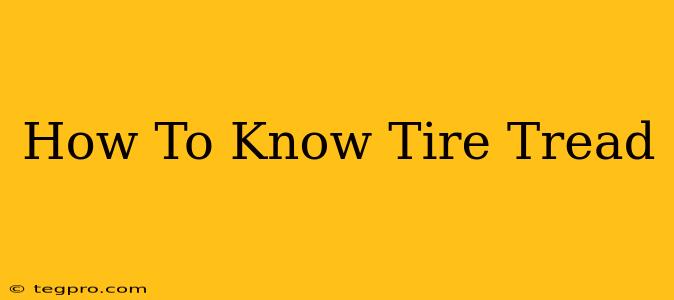Knowing your tire tread depth is crucial for safety and longevity. Under-inflated tires with insufficient tread are dangerous and can lead to accidents. This comprehensive guide will teach you how to check your tire tread, understand what the measurements mean, and know when it's time for new tires.
Why Checking Tire Tread Depth Matters
Your tires are the only contact point between your vehicle and the road. Sufficient tread depth ensures:
- Optimal grip: Adequate tread provides essential grip, especially in wet or icy conditions, preventing hydroplaning and skidding.
- Improved braking distance: Worn tires significantly increase braking distance, putting you and others at risk.
- Enhanced handling: Good tread ensures responsive steering and control, particularly in challenging driving situations.
- Increased fuel efficiency: Properly inflated tires with sufficient tread minimize rolling resistance, improving your gas mileage.
- Extended tire lifespan: Regularly checking your tread can help you catch potential problems early, prolonging the life of your tires.
Methods for Checking Tire Tread Depth
There are several ways to check your tire tread depth:
1. The Penny Test: A Simple and Effective Method
This is the most common and readily available method. Here's how to do it:
- Insert a penny: Place a Lincoln penny, head-down, into the tread groove of your tire.
- Check Abraham Lincoln's head: If you can see all of Abraham Lincoln's head, your tread depth is less than 2/32 of an inch, and it's time to replace your tires.
- Repeat across the tire: Perform this test in several locations across each tire to ensure consistent tread depth.
Important Note: The penny test only checks the minimum legal tread depth. It's best practice to replace tires before they reach this critical point.
2. The Tread Depth Gauge: For Precise Measurement
A tread depth gauge provides a more accurate measurement of your tire tread. These inexpensive tools are readily available at auto parts stores. Simply insert the gauge into the tread groove and read the measurement. Most gauges are designed to measure tread depth in 32nds of an inch.
3. Visual Inspection: Look for Wear Indicators
Most tires have built-in wear bars, small indicators molded into the tread pattern. When the tread wears down to the level of these bars, it's a clear signal to replace your tires.
Understanding Tread Depth Measurements
Tire tread depth is usually measured in 32nds of an inch. Most experts recommend replacing your tires when the tread depth reaches 2/32 of an inch (or less). However, optimal performance and safety are best achieved with a tread depth of at least 4/32 of an inch.
Optimal Tread Depth: 4/32 inch or more
Legal Minimum Tread Depth: 2/32 inch (varies by location – check your local regulations)
When to Replace Your Tires
Several factors indicate it's time for new tires:
- Tread depth: As discussed above, when the tread depth reaches 2/32 of an inch or less.
- Uneven wear: If one part of the tire wears down faster than others, it may indicate an alignment problem that needs attention.
- Cracks or bulges: Visible cracks or bulges in the sidewall indicate tire damage and require immediate replacement.
- Age: Even if the tread depth is still good, tires can degrade with age. Check the sidewall for the manufacturing date and consider replacement after 6-10 years, regardless of tread depth.
Conclusion: Prioritize Tire Safety
Regularly checking your tire tread depth is a simple yet crucial aspect of vehicle maintenance. By following the methods outlined in this guide, you can significantly improve your safety, fuel efficiency, and prolong the lifespan of your tires. Remember, your tires are your connection to the road; don't compromise on safety.

